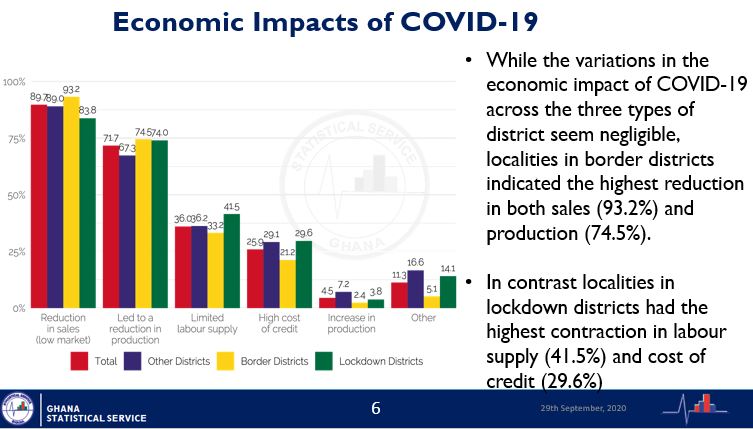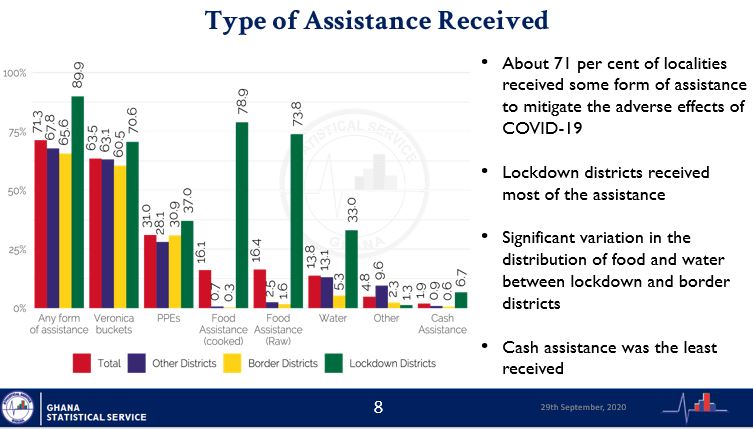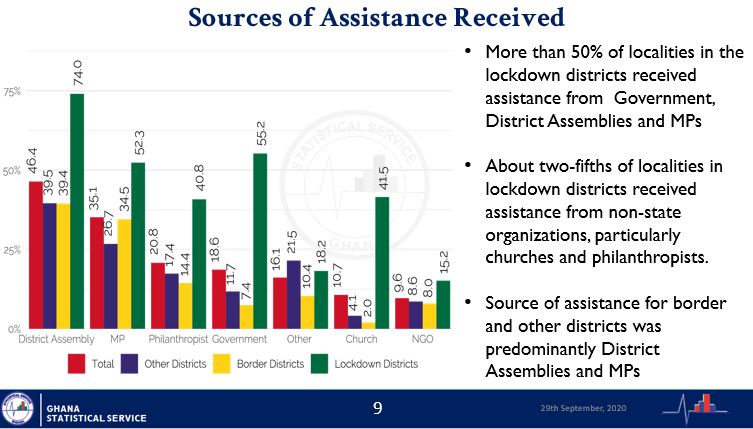7 out of 10 communities received COVID-19 support – Statistical Service
A survey by the Ghana Statistical Service (GSS) has revealed, seven out of ten localities received support at the height of Ghana’s coronavirus fight.
A chunk of the support was in the form of food and personal protective equipment (PPEs).
This was contained in a Local Economies Tracker by the GSS in collaboration with the United Nations Development Programme (UNDP).
This was conducted using a sample of 2,770 communities across the 16 regions of the country.
Majority of Ghanaians, however, received help with 71% of localities receiving some form of assistance to mitigate the adverse effects of COVID-19.
In terms of the source of the support, more than 50% of localities received assistance from Government and District Assemblies with Members of Parliament (MPs) being the largest source of assistance to communities.
Notably, many communities received assistance from non-state organizations, particularly from churches (41.5%), and philanthropists (40.8%).
Lockdown districts received the most extensive assistance in comparison to the rest.

Out of the total number of localities surveyed: 554 of them are in districts that were in lockdown areas; 1,169 were in districts that share international borders with other countries (border districts), and 1,047 were neither in lockdown nor border districts (other districts).
It was undertaken from May to June 2020 and data was collected from key opinion leaders to understand the effect of COVID-19 on the local economy, particularly in localities in border districts, lockdown and non-lock down areas.
“COVID-19 has undoubtedly had a devastating impact on households, businesses, and the local economy in Ghana”, noted Professor Samuel Kobina Annim, Government Statistician.
On the part of the UNDP, its Resident Representative in Ghana said: “Support received by the communities from churches and philanthropists is a clear demonstration of how non-state actors have and continue to complement government’s efforts to ensure communities recover better from the pandemic. Partnerships like these are key for the achievement of the SDGs”.

Even though district assemblies were the main source of direct support and driver of social and political initiatives, over 75% of localities indicated that their district assemblies have not taken economic initiatives to lessen the economic impact of COVID-19.

Few district assemblies initiated economic mitigating measures such as alternative markets for local produce, subsidies on inputs and soft loans for businesses/farmers.
Source of assistance for border and other districts was predominantly District Assemblies and MPs.
Negative economic impact
About 72% and 90% of local businesses saw reductions in production and sales, respectively.
Furthermore, businesses faced labour shortages and high cost of credit during the lockdown.
Prices of almost all products increased, with food and non-alcoholic beverages experiencing the highest price increase of 4.8%.
Even though district assemblies were the main source of direct support and driver of social and political initiatives, over 75% of localities indicated that their district assemblies have not taken economic initiatives to lessen the economic impact of COVID-19. Few district assemblies initiated economic mitigating measures such as alternative markets for local produce, subsidies on inputs and soft loans for businesses/farmers.
Resilience to COVID-19 was lower in the lockdown districts relative to the other districts.
This suggests a longer duration for lockdown districts to fully recover from the effects of the COVID-19 pandemic.
55.1% of localities have in place social structures at the district level that will help them recover from future shocks, such as COVID-19.
The most common structures are district standing committees, community development committees and business assistance committees.
Approximately 38% of localities think it will take more than a year for the local economy to recover from the COVID-19 pandemic.



